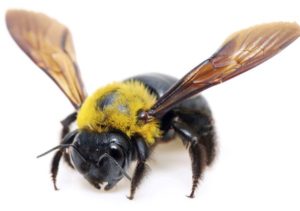Woodpecker / Carpenter Bee Connection
 Woodpeckers can become a real nuisance when they make holes in the wood elements of clients’ homes.
Woodpeckers can become a real nuisance when they make holes in the wood elements of clients’ homes.
Occasionally, woodpeckers just make the holes to attract mates or for territorial marking.
But most of the time, woodpeckers drill holes looking for food.
One of their favorite foods is carpenter bee larvae.
To the right is an adult carpenter bee: a type of bee that makes dime size tunnels into pieces of wood where they lay eggs.
They gather pollen and nectar from flowers but they also create little piles of sawdust as they chew their way inside pieces of wood. They aren’t eating the wood.
In the tunnel in the wood, they lay their eggs and leave some food. Once these eggs hatch, there isn’t a little bee present, instead it is a juicy larva. The larva develop through the summer and eventually metamorphose into adult carpenter bees.
During the summer, the woodpeckers can hear these larvae behind the wood. So, they drill holes into the side of the home and eat up.
We get called for the woodpecker problem. Often, there is carpenter bee problem that needs addressed as well.
Carpenter Bee / Woodpecker Connection Video
In this video Ryan shows a cross-section of a piece of wood that a carpenter bee worked on.
It is pretty cool and explains why woodpeckers bore holes to get at these tunnels.

As mentioned, his advice is to care of the bees. Then the problem usually doesn’t exist.
We don’t use chemicals and spray for insects; we leave that for insect/pest control specialists. But, we do deal with woodpeckers and woodpecker damage.
Woodpecker Removal?
Some ask if we remove woodpeckers. The best answer is sometimes, but only when a homeowner has gotten the correct permits.
Woodpeckers (as most all birds) are federally protected.
What that means is, generally speaking, woodpeckers are not allowed to be removed, killed, or otherwise harmed unless they are deemed a nuisance.
In extreme cases, property owners are allowed to petition the U.S. Department of Fish and Wildlife or the U.S. Department of Agriculture APHIS Wildlife Services (WS) for a special license/permit. But, before either of these agencies would issue a permit, you can be sure they will suggest habitat modification first.
Thus habitat modification, non-harmful harassment, and making repairs is what we recommend to people with woodpecker problems.
Habitat modifications for woodpeckers include covering areas of damage with netting, mesh, or metal.
Non-harmful harassment includes noise making, hanging of shiny objects, and the use of all kinds of predator facsimiles.
Making repairs restores the property after the woodpecker has already moved on.
If the birds continue to be problematic, we can advise you how to go about obtaining a permit and help with the removal.
We do make repairs of woodpecker damage.
Bird Removal for Akron, Canton, Kent
While woodpeckers are protected, the big three nuisance birds which are considered invasive and have no protections are:
- Starlings
- English Sparrows
- Pigeons
If you have these birds or their nests and they are a nuisance, give us a call.
Also give us a call if you would like to have woodpecker damage repaired.

